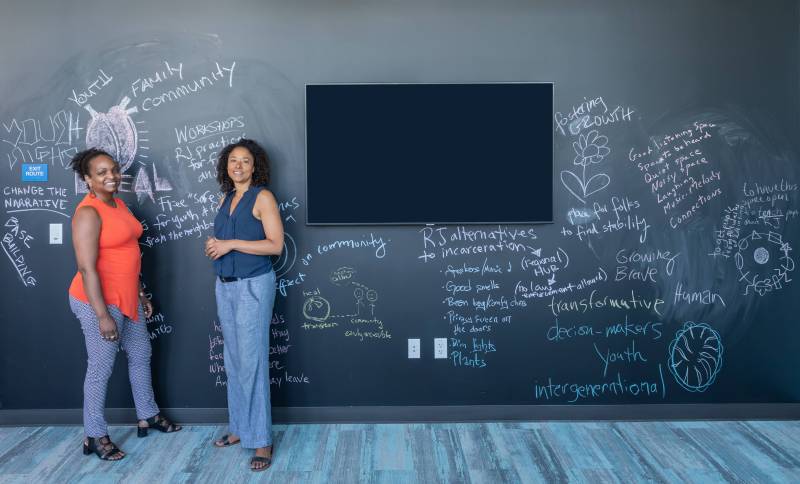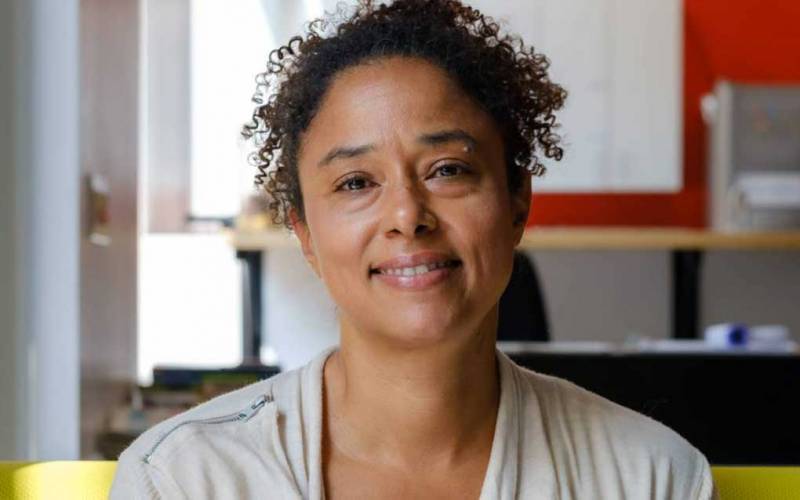Deanna Van Buren is an architect, but she goes far beyond just designing buildings. She uses her craft to demonstrate new structures for justice in our society.
Van Buren is the co-founder and Executive Director of Designing Justice, an organization that she says focuses on “ending mass incarceration through innovations in the built environment, using both finance and design together.”

Designing Justice has launched projects across the country: They’re behind a Peace Making project in Syracuse, a restorative justice project in Detroit, and they’re looking to convert an Atlanta jail into a community center.
Locally, they’ve refurbished a MUNI bus to create a mobile school in San Francisco and in East Oakland, they’ve built a community center based in restorative justice practices.
This week on Rightnowish, Deanna Van Buren discusses what it means to design for a more equitable society.
Below are lightly edited excerpts of my conversation with Deanna Van Buren.
Deanna: Recently we finished Restore Oakland… And Restore Oakland is the country’s first Center for Restorative Justice and Restorative Economics. And that inspired another project just like it in Detroit, called the Love Buildings. We’re also doing more community organizing work in L.A. County to create a restorative care village… We’re creating a tool that’s building out the entire infrastructure that we believe is necessary to end mass incarceration, so that communities can plan their neighborhoods differently. So it’s a huge range… I could keep going but [laughs]
Pen: It’s a lot, It’s a lot, that’s a lot of balls in the air.
Deanna: I got more, I got more [laughs]
Pen: And you’re traveling even during this time, this crazy time?
Deanna: Yeah, Pen cause we’re essential workers. Dismantling racism and unbuilding racism is essential work. I can’t stop. I mean, we go safely. We’re really safe. We social distance. We wear masks. But I’m not gonna stay at home when there’s that kind of work to be done.
Pen: Well, when you put it like that. Like yeah. That’s the most essential work. Duh. My bad… Okay but how do you actually transform a space like [prisons and jails]? I’m thinking of the county jail in San Francisco that recently got shut down. How can we see it turned into something else?
Deanna: Yeah. So… especially with these facilities, they’ve done so much harm. A community looks at these spaces and these buildings and there’s a lot of trauma there.
Deanna: They can be repurposed. It’s costly to repurpose because they were built to hurt people, to punish, and separate. And now you want to turn it into housing, or you want to turn it into a center for equity, or you want to turn into live work space for artists… all these ideas… But there are no windows, right? The whole thing’s chopped up with a bunch of concrete walls. You’ve got to get rid of all that. All that’s got to go. Sometimes it’s cheaper to tear the thing down and start again. And you got to engage the community in that. You gotta repair the harm by engaging folks and reimagining it so it’s some place they’d actually feel comfortable going.
Deanna: I mean, one initiative we have is to turn them into trade schools, welding schools. We call it the welding justice project. You know, if you’re going to repurpose these facilities, you have to bring restorative economics into it. How does this actually generate revenue and bring jobs into the community that are living wage and growth jobs? You gotta stack some functions here.
Pen: What’s your thoughts on the newly built prisons that are built with restorative justice practices in mind or are built with intelligent architecture for lack of a better term?
Deanna: We have this conversation, a lot, Pen. Here are my thoughts about it: I don’t think you can build prettier boxes to house black and brown people built on the foundations of a structurally racist system. I don’t. That’s not where the resources need to go.
Deanna: Anytime you build a better looking prison or jail, you’re taking resources out of the community. The investment you’re putting into the building of that infrastructure is investment you’re not putting into reentry. You’re not putting into educational programs and services. You know, we look to these prisons we see in Europe that are really beautiful and but they’re built totally on a different system. They have very few people incarcerated. They have very low recidivism rates because they actually be-believe in repair like that these are citizens, and they’re not based in slavery. Right? It didn’t come from a system of enslavement. Our system is. So the prettier box ain’t gonna to do it. Design is not going to solve the problem.

Rightnowish is an arts and culture podcast produced at KQED. Listen to it wherever you get your podcasts or click the play button at the top of this page and subscribe to the show on NPR One, Spotify, Apple Podcasts, TuneIn, Stitcher or wherever you get your podcasts.


